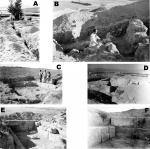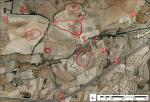Summary (English)
Research (2003-2004)
Very close to the current town of Baza (Granada) is located the archaeological complex of Basti –declared Heritage of Cultural Interest in 2003– which corresponds to the ancient Iberian and Roman settlement mentioned in graeco-latin sources. Cerro Cepero is located in a privileged position, which made it a key point in transportation routes, an important commercial centre and settlement area of different and cultures for more than a thousand years. The settlement that lies on this circular hill, with an extension of about 6 ha, dates back to the Late Bronze Age (10th to 9th centuries BC) until the 8th century, with a temporal reoccupation in the Late Medieval period. Its long existence caused a consequent loss of information.
It is a very vast archaeological site, broad both geographically and chronologically, whose extension is of about 135 hectares. An Iberian oppidum is located there, which evolved into a civitas stipendiaria in Roman times and into a possible Visigothic monastery during Late Antiquity. In the 14th century a Nasrid vantage point was built.
In 1955, excavations led by F. Presedo, A. Casas y J. Eguaras are already mentioned. Even though the information is unclear, we know that the Comisaría General de Excavaciones Arqueológicas granted an intervention project in Cerro Cepero to J. Eguaras and F. Presedo that could be prolonged between 1953 and 1956. Data from these interventions are scarce; however, there is evidence of elements from the Bronze Age, like the documentation of a baptistery on the top of the hill, surrounded by a necropolis for children and the discovery of a Roman statue in a wall «from Barbarian times».
Between 1987 and 1991, a team led by N. Marín, from the University of Granada, returned to work in Cerro Cepero. Their interventions were aimed at recovering part of the previous excavations: the nymphaeum area or the water cistern and the thermae in the southern end, the central area and three prospections in the northern directions to delineate the site and explain the changes in the relief that were made. Some restoration and conservation works were also carried out.
In 2003, under the leadership of A.M. Adroher, other emergency interventions were developed, due to the Negratín reservoir to the Almanzora valley. A series of sondages was then made between Cerro Cepero and Cerro Largo, all but three of which were negative.
Halfway through the series, almost crossing the river which separates the two hills, we found the foundation of a domestic unit from the 1st/2nd century BC and near the motorway, a small settlement from Late Antiquity with a necropolis. We also found the small and relatively late Iberian necropolis of Las Viñas. In the surveys carried out during the excavation, a small Early Medieval domestic unit was also documented at the foot of Cerro Largo on its Eastern side. This way, a quite complete map of an archaeological complex that was notably larger than the one set by the declaration of the Asset of Cultural Interest could be made for the first time.
In 2004, a year after this emergency archaeological intervention took place, the project “Iberismo y romanización en el área nuclear bastetana” started, coordinated by the University of Granada and the Museo Municipal de Baza and approved by the General Directorate of Cultural Property of the Andalusian Regional Government. This project, not completed, but closed due to the economic crisis, has left many unfinished objectives; only a cleaning intervention (2005 campaign) and another archaeological excavation (2006), both in Cerro Cepero, could be made.
From that moment on, only permissions aimed at the study of the archaeological materials retrieved were granted. As a consequence of these works, we can say that Cerro Cepero was occupied from the Late Bronze Age, as it also happened with other central Bastetani oppida (_Iliberri_, Acci, Tutugi, etc.). As a result of the cleaning and sifting of some of the spoil heaps during the excavations in the 60s-70s of the last century, interesting materials from the Iberian period have been documented. These have been the subject of detailed studies (Sieg, 2013; Ruiz de Haro, 2014; Negrillo, 2014). Other part of the intervention was focused on the recovery of the original landscape of the necropolis; numerous works about it have been published and it is one of the most referenced in the historiography of Iberian necropolis (Adroher y Caballero, 2010; Risquez et al., 2010).
We also located another small and rather late Iberian necropolis called Las Viñas during the campaign in 2003, almost at the foot of Cerro Cepero. Even though the oldest excavated Iberian levels until now belong to the 2nd century BC, documented thanks to the ceramic material, the foundation of the settlement dates back to an indeterminate time between the Late Bronze Age (10-11th) and the Ancient Iberian period (8-9th).
Related to the Roman occupation, in Basti there seemed to be no interruption with the Iberian settlement. Romanization involved the construction of some necessary urban elements, but the neighbourhood kept the same structure it had in previous stages. The Roman constructions are purely administrative: the thermae, the forum area and the hydraulic systems.
The works have revealed a stratigraphic hiatus between the 4th and 6th centuries AD. That is, after having been abandoned for a few centuries, there was a new reoccupation, or at least a reordering of the space in the plateau of Cerro Cepero, probably foreign to the Roman municipality. For some time, the site was used as a construction quarry. For that reason, when it was occupied again, the buildings were partially ruined, but the building distribution of the ancient Roman town is perfectly visible.
In the Visigothic period, with such circumstances, the old buildings were rebuilt with scarce remodelling and changes in the urban fabric. Some modifications can be noticed in the wall distribution or in the new internal partitions in the bigger structures. Among them, the maintenance of the old forum without any remodelling stands out because of its importance in the urban development, constituted as a simple open space.
The last inhabited moments of Cerro Cepero are well into the 8th century AD. From the chronological point of view, we are in the Emiral period and some of the materials retrieved can be clearly assigned to the new cultural Islamic fashions. However, the population that was settled here was undoubtedly Christian, in its origin and durability.
Everything seems to indicate that this settlement was gradually abandoned in the course of the 8th century AD. It was probably a military detachment without functions since the establishment of the new North African power. It is likely that the population was forced to move to the new location of Madinat Baztain Cerro del Quemao, leaving Cerro Cepero deserted. There is no evidence of anthropic building activity until the construction of a vantage point in the 14th century.
- 2003-2004
This intervention is included in the project “Iberismo y Romanización en el área nuclear bastetana”, approved by the Andalusian Regional Government, which founded the entire project. The main objectives were the study and evaluation of the sites of Cerro Cepero and the Iberian necropolis of the Sanctuary hill, where the Lady of Baza was found in 1971. The project considered the documentation, cleaning and consolidation of the identified structures from the previous excavations. The materials retrieved by these works were associated to the cleaning process of these structures. Therefore, most of them are altered eroded materials with a small contextualization valueParallel to that, during this first campaign, the superficial archaeological exploration of the Bastetani territory up to the boundaries with the big neighbouring oppida (_Tútugi_, in Galera, in the North and Acci, in Guadix, in the South) was planned.
(translation by Andrea Jorde Pérez)
- Andrés María Adroher Auroux
Director
- Andrés María Adroher Auroux (Universidad Granada)
- Lorenzo Sánchez Quirante (Museo Municipal de Baza)
Team
- Amparo Sánchez Moreno, José María Alonso, Francisco Javier Brao González, Alejandro Caballero Cobos, Stefano Ferrario, Mª Ángeles Jiménez Higueras, Verónica Navarrete Pendón, Antonio Pizarro López, Juan Luis Rivas, Nieves Ruiz Nieto, Juan Antonio Sal
- Andrés María Adroher Auroux (Universidad Granada)
Research Body
- Museo Municipal de Baza
- Universidad de Granada
Funding Body
- Ayuntamiento de Baza
- Junta de Andalucía






![Download [PDF]](/excavation/skins/fasti/images/results/download_sml.png)

